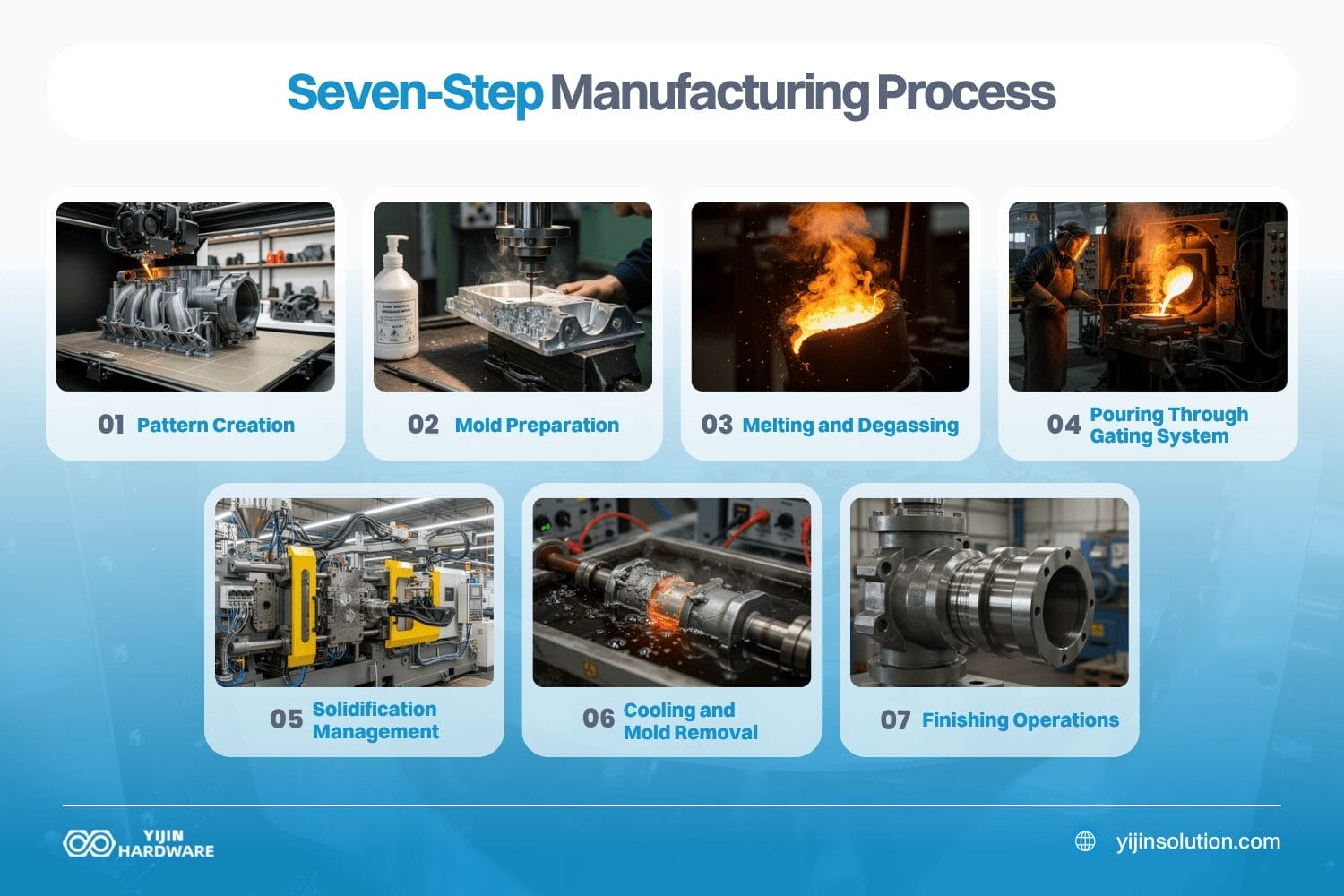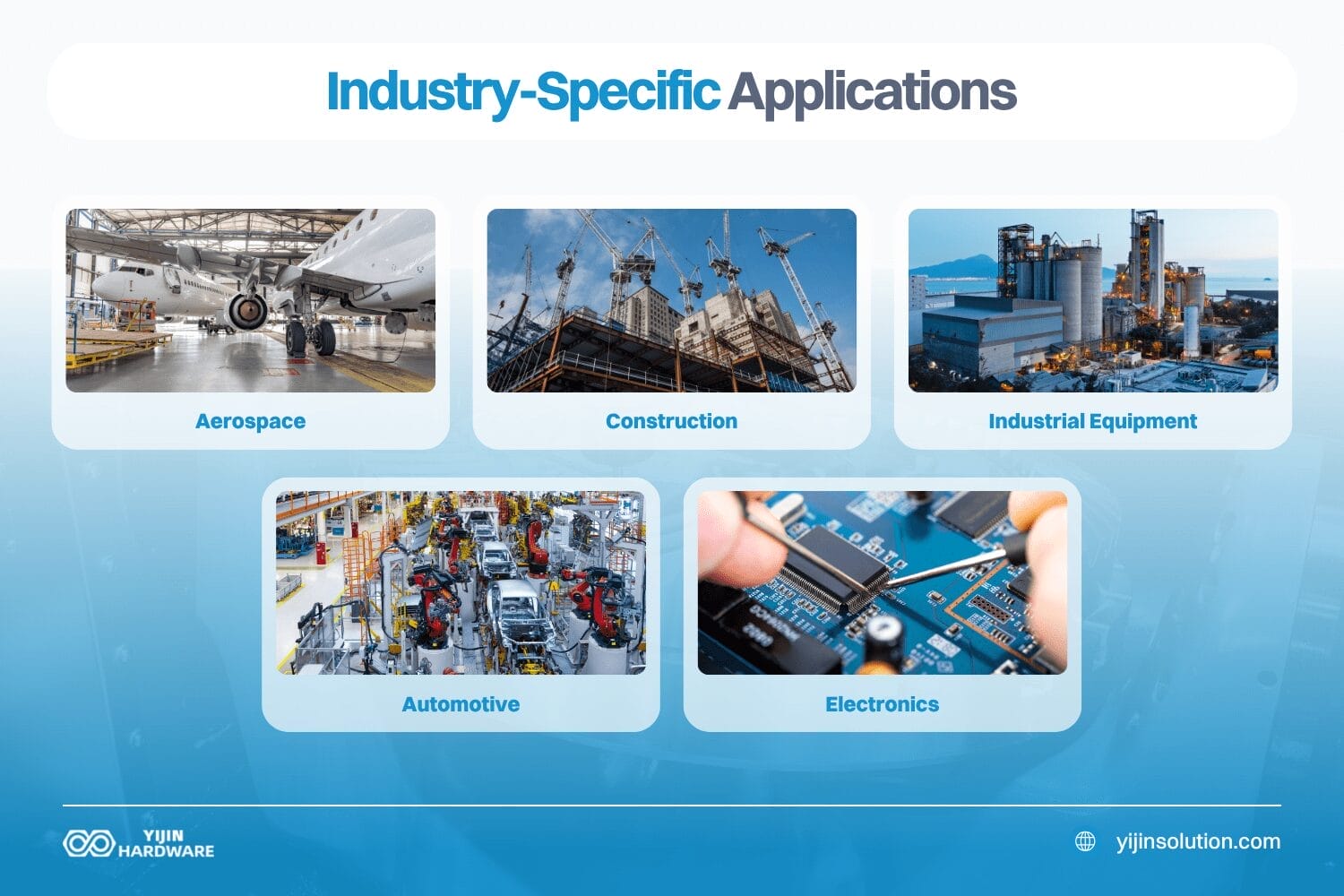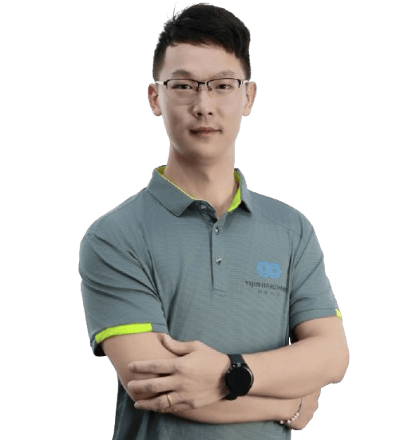Pick the wrong aluminum alloy or casting method, and you’re looking at thousands wasted on tooling and months of production delays. With over 40 cast aluminum alloy options and six major casting processes out there, a bad choice means you’ll be dealing with porosity issues, parts that don’t match your dimensions, or worse, mechanical failures once the product’s in use. Knowing your cast aluminum properties, alloy types, and which process fits your needs saves you from all that headache.
At Yijin Hardware, we machine cast aluminum parts every day and help clients figure out the right alloy, evaluate casting methods, and handle post-casting finishing. We deliver precision components that meet ASTM B26 and ISO 3522 standards.
Key Takeaways
- Cast aluminum alloys contain 10-12% alloying elements versus 1-2% in wrought aluminum for superior fluidity
- Four alloy families (AlSi, AlCu, AlMg, AlZn) serve different applications based on strength, corrosion resistance, and thermal properties
- Die casting delivers ±0.1 mm tolerances; sand casting offers flexibility for complex geometries at lower tooling cost
- ASTM B26 and ISO 3522 standards govern quality requirements, inspection frequencies, and acceptance criteria
- Global aluminum casting market reached USD 100.94 billion in 2024, growing at 4.9% CAGR through 2030
What is Cast Aluminum and Why is it Widely Used?
Cast aluminum is an aluminum alloy melted to 680-750 °C, where molten aluminum is poured into molds to form specific shapes upon solidification. The material contains 10-12% alloying elements compared to 1-2% in wrought aluminum according to ScienceDirect, providing improved fluidity and superior mold filling capability. This higher alloy content enables complex geometries impossible to achieve through machining or extrusion operations.
The global market reached USD 100.94 billion in 2024 with projected 4.9% CAGR growth through 2030 based on Grand View Research data. Applications span aerospace landing gear, automotive engine blocks, medical equipment frames, electronic heat sinks, and architectural facades where this lightweight metal delivers exceptional performance.
Cast aluminum offers natural corrosion resistance from oxide layer formation without additional surface treatment. Near-net shape capability reduces subsequent machining by 30-60% compared to fabricating from solid stock, making cast aluminum an ideal material for cost-effective manufacturing.
What are the Four Main Types of Aluminum Casting Alloys?
The difference between cast aluminum families lies in primary alloying elements: Aluminum-Silicon (AlSi), Aluminum-Copper (AlCu), Aluminum-Magnesium (AlMg), and Aluminum-Zinc (AlZn). Each family delivers distinct properties optimized for specific performance requirements. Silicon content ranges from 7-13% for most die casting and up to 25% for special cases, largely for improved fluidity, copper provides 4.5-5.3% strength enhancement, and magnesium offers superior protection in harsh environments.
Aluminum-Silicon (AlSi) Alloys
AlSi alloys contain 16-18% silicon, and up to 25% for special cases, according to Sunrise Metal research, representing the most common aluminum casting types for housings, frames, and structural components.
Key characteristics:
- Silicon improves wear resistance and thermal fatigue properties
- Optional magnesium additions (0.3-0.6%) enable T6 heat treatment response
- Thermal conductivity: 120-180 W/m·K for effective heat dissipation
- Common grades: AlSi10Mg, AlSi7Mg03, AlSi9Cu3, AlSi12
These cast aluminum alloys achieve 180-280 MPa tensile strength as-cast, increasing to 240-320 MPa after T6 heat treatment.
Aluminum-Copper (AlCu) Alloys
AlCu alloys contain 4.5-5.3% copper, with additional manganese and titanium per Sunrise Metal data. These alloys deliver 240-340 MPa tensile strength and excellent machinability for dynamic load components, though aluminum requires protective coatings for outdoor use due to lower corrosion resistance.
Aluminum-Magnesium (AlMg) Alloys
AlMg alloys achieve the lowest density at 2.55 g/cm³ with the highest strength reaching approximately 355 MPa per Sunrise Metal research. The nature of cast aluminum with magnesium content provides excellent protection in marine and chemical processing environments, where aluminum withstands saltwater exposure without degradation. Common grade AlMg3 serves aerospace radar bases, landing gear, and marine hardware.
Aluminum-Zinc (AlZn) Alloys
AlZn alloys use zinc as base with added silicon and magnesium for improved casting performance per Sunrise Metal specifications. These alloys provide dimensional stability after heat treatment, with aluminum and zinc combinations offering lower melting points than pure aluminum while maintaining structural integrity for precision tooling applications.
How does the Aluminum Casting Process Work?
The casting process transforms solid alloy into molten metal at 660-750 °C, where aluminum is heated and poured into prepared molds through controlled gating systems. Processing time ranges from 2–48 hours depending on part size and method. The material shrinks approximately 6 to 7% by volume during solidification, requiring risers and proper gating design to prevent defects in the final cast product.
Seven-Step Manufacturing Process

- Pattern Creation: Replica produced using wood, plastic, or metal as raw material with 1.0-1.3% shrinkage allowance and 0.5-3 mm machining stock on precision surfaces.
- Mold Preparation: Pattern placed in flask with sand, plaster, or metal material. One-part molds for simple geometry, two-part for complex features.
- Melting and Degassing: Induction or resistance furnace heating to alloy-specific temperature. Degassing removes dissolved hydrogen to below 0.10 mL/100 g. Hydrogen solubility drops from 0.69 mL/100 g at liquidus to 0.04 mL/100 g at solidus.
- Pouring Through Gating System: Controlled flow rate minimizes turbulence and gas entrapment. Gating includes sprue, runner, gate, and riser components.
- Solidification Management: Directional solidification from thin to heavy sections prevents shrinkage. Cooling rate affects grain structure and mechanical properties as material transitions to solidify.
- Cooling and Mold Removal: Cooling to below 200 °C handling temperature. Sand molds broken away, permanent molds opened, die-cast parts extracted using ejector pins.
- Finishing Operations: Gate and riser removal, flash trimming, surface cleaning, dimensional inspection with CMM equipment, and secondary CNC machining for critical features.
What’s the Difference Between Sand Casting, Permanent Mold Casting, and Die Casting?
The differences between cast aluminum methods include tolerance capability, production volume, and tooling investment. Sand casting uses expendable sand molds for flexible production with ±0.5 mm tolerances, permanent mold casting uses reusable steel molds for ±0.3 mm accuracy, while aluminum die casting injects molten aluminum under high pressure (10-175 MPa) achieving ±0.1 mm tolerances per LeClaire Manufacturing analysis.
| Factor | Sand Casting | Permanent Mold | Die Casting |
|---|---|---|---|
| Tolerance | ±0.5–2.0 mm | ±0.3–0.5 mm | ±0.1–0.3 mm |
| Surface Finish | Ra 6–25 μm | Ra 3.2–6.3 μm | Ra 1.6–3.2 μm |
| Min Wall | 3–5 mm | 2.5–4 mm | 0.5–2 mm |
| Tooling Cost | $500–5,000 | $10,000–100,000 | $60,000–500,000+ |
| Volume Range | 5–50 parts | 50–200 parts | 10,000+ |
Sand casting is one of the most flexible methods, delivering the lowest tooling investment and accommodating cast parts from 100 g to several tons.
Permanent mold casting uses gravity to fill the mold cavity, providing 30-50% reduction in machining time through improved surface finish. Casting uses high-pressure injection producing 200-2,000 parts per day with lowest per-part costs above 10,000 units, though lead time reaches 8–16 weeks for die fabrication.
What Properties Make Cast Aluminum Valuable?
Cast aluminum boasts 355 MPa tensile strength at only 2.55 g/cm³ density for AlMg3 alloys per Sunrise Metal specifications, thermal conductivity of 120-180 W/m·K, and natural corrosion resistance from protective oxide layer formation. The weight of the cast aluminum remains 67% less than steel at 7.85 g/cm³ and 35% lighter than titanium at 4.5 g/cm³, making aluminum a lightweight solution for demanding applications.
Mechanical and Thermal Properties
Strength-to-weight performance:
- Density: 2.55-2.85 g/cm³ across alloy families
- Tensile strength: 150-355 MPa depending on alloy and heat treatment
- Specific strength: AlMg3 achieves 139 kN·m/kg comparable to iron and steel
- Thermal conductivity: 3-4× better than stainless steel (15-45 W/m·K)
- Melting point of cast aluminum: Lower than wrought aluminum for easier processing
Machinability and Surface Treatments
Machinability rating of 8-9/10 enables cutting speeds of 200-1,500 m/min, where the machine processes material 5-15× faster than steel. Post-casting CNC operations achieve ±0.01 mm tolerances with Ra 0.4-1.6 μm surface finish. While welding cast aluminum poses challenges due to porosity, TIG welding can successfully join cast parts when proper procedures are followed.
Surface treatment options include Type II anodizing for decorative finishes, Type III hard coat for wear resistance, powder coating for UV-resistant durability on cast aluminum patio furniture, and chromate conversion for electrical conductivity maintenance.
Where do Industries Use Cast Aluminum?

Applications of cast aluminum span aerospace landing gear, automotive engine blocks at 65-70% of global market demand, electronic heat sinks, construction facades, industrial pumps, medical equipment, and consumer products. Electric vehicle adoption drives a 20-30% increase in usage for battery housings and motor components, according to industry forecasts.
- Aerospace: Landing gear assemblies, wing structures, engine housings use AlMg3 and AlSi7Mg03 alloys meeting FAA and EASA certification with 20,000+ flight cycle fatigue resistance. Boeing 787 uses 20% aluminum by weight, saving 15 tons versus the previous generation.
- Automotive: Engine blocks, cylinder heads, transmission cases, suspension components, wheels using AlSi10Mg, AlSi7Mg03, and AlSi12 alloys. 10% weight reduction yields 6-8% fuel efficiency improvement. Tesla Model 3 battery housing uses a single die-cast component, replacing 70 parts.
- Electronics: CPU/GPU heat sinks, LED housings, power supply enclosures, RF shielding with 120-180 W/m·K thermal conductivity dissipating 50-300 W+ heat loads. Complex fin geometries and internal cooling channels cast-in meet IP65-IP68 ingress protection standards.
- Construction: Building facades, window frames, curtain walls providing 30-50 years service life in outdoor environments with anodizing and powder coating in unlimited colors. Lightweight construction reduces structural loading requirements.
- Industrial Equipment: Pump housings, valve bodies, compressor housings, hydraulic manifolds operating at 10-250 bar pressure ratings using AlSi10Mg for general purpose and AlCu4MgTi for high-strength applications with complex internal porting cast directly.
What is Yijin Hardware’s Cast Aluminum Machining Process?
- Design for Manufacturability: We review designs for machinability optimization, recommending 0.5-2 mm machining stock on precision surfaces, identifying potential defects in high-stress areas, and suggesting alloy selection based on performance requirements.
- Casting Source Coordination: Assist sourcing from qualified foundries meeting ASTM B26 and ISO 3522 requirements, inspect incoming castings for porosity and dimensional accuracy, perform X-ray fluorescence (XRF) testing to confirm alloy composition, and reject defective castings before machining.
- Precision Machining: DMG Mori 5-axis machining centers handle complex contours in single-setup operations. Haas CNC lathes deliver high-volume consistency. Alloy-specific optimization uses carbide tooling for AlSi alloys (10-25% silicon content), extended tool life approaches for AlCu alloys, and sharp tools for AlMg alloys preventing smearing.
- Quality Inspection: CMM (Coordinate Measuring Machine) dimensional verification, profilometer surface finish testing, visual inspection for defects, and complete documentation with actual versus specified measurements.
What Quality Standards Apply to Cast Aluminum?
ASTM B26 specifies aluminum-alloy sand castings covering chemical composition, mechanical properties, and three quality levels (Q1, Q2, Q3) with increasing inspection rigor. ISO 3522 provides international standards for all casting methods. The Aluminum Association maintains official alloy registrations and temper designation systems (F, O, T4, T6).
| Quality Level | Inspection | Testing | Use Cases |
|---|---|---|---|
| Q1 Standard | 5-10% sampling | One test per heat | Non-critical, low-stress |
| Q2 Enhanced | 10-25% sampling | Frequent testing, selective X-ray | Automotive, industrial |
| Q3 Critical | 100% critical features | Individual casting tests, 100% X-ray | Aerospace, medical |
Deciding between cast aluminum alloys and manufacturing methods requires expertise in material science, process capabilities, and application requirements. At Yijin Hardware, we combine deep knowledge of various aluminum casting types with precision CNC machining to deliver high-quality aluminum components that meet your exact specifications.
Contact our engineering team today for a design for manufacturability review. We’ll help you select the optimal alloy, recommend the most cost-effective casting method for your volume, and ensure your cast aluminum parts achieve the dimensional accuracy and surface finish your application demands.
Cast Aluminum FAQs
Is cast aluminum good quality?
Cast aluminum is generally high-quality when manufactured following ASTM B26 or ISO 3522 standards, with performance depending on correct alloy selection (AlMg3 for marine, AlSi10Mg for thermal, AlCu4MgTi for strength) and appropriate quality level choice (Q1 non-critical, Q3 aerospace).
What are the disadvantages of cast aluminum?
Cast aluminum vs wrought aluminum shows lower tensile strength (150-355 MPa versus 300-600 MPa) due to grain structure, plus casting defects like porosity can compromise properties if process control fails, and poor resistance to strong acids/alkalis (pH below 4 or above 9) limits chemical applications.
Is cast aluminum worth anything?
The cost of cast aluminum scrap maintains recycling value at $0.35-0.55 per pound (40-60% of primary aluminum market price based on London Metal Exchange), requiring only 5% of energy versus primary production while retaining 95% of material properties per International Aluminium Institute data.
Back to Top: Cast Aluminum | Everything You Need to Know About Alloys, Casting, and Machining









